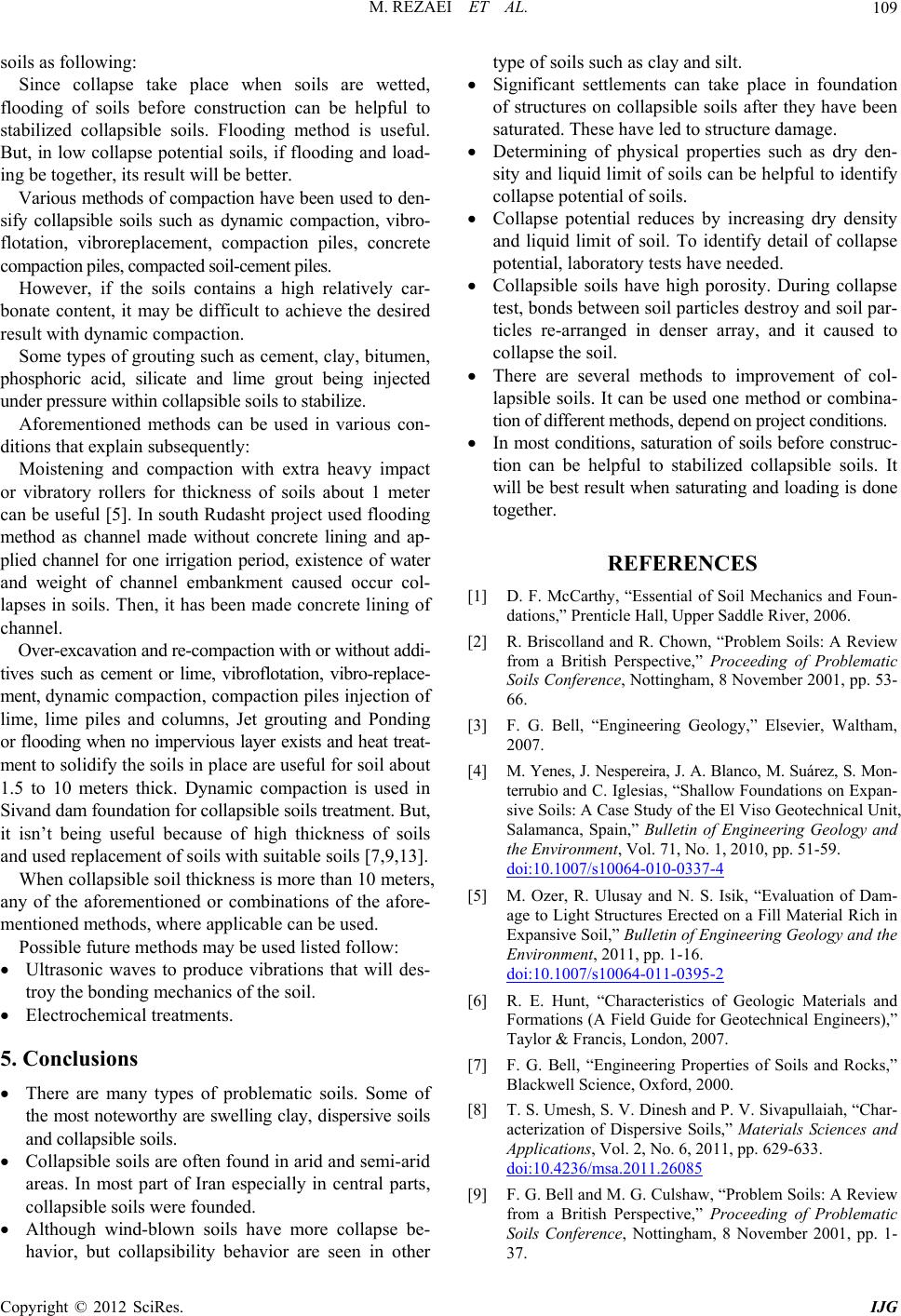
M. REZAEI ET AL. 109
soils as following:
Since collapse take place when soils are wetted,
flooding of soils before construction can be helpful to
stabilized collapsible soils. Flooding method is useful.
But, in low collapse potential soils, if flooding and load-
ing be together, its result will be better.
Various methods of compaction have been used to den-
sify collapsible soils such as dynamic compaction, vibro-
flotation, vibroreplacement, compaction piles, concrete
compaction piles, compacted soil-cement piles.
However, if the soils contains a high relatively car-
bonate content, it may be difficult to achieve the desired
result with dynamic compaction.
Some types of grouting such as cement, clay, bitumen,
phosphoric acid, silicate and lime grout being injected
under pressure within collapsible soils to stabilize.
Aforementioned methods can be used in various con-
ditions that explain subsequently:
Moistening and compaction with extra heavy impact
or vibratory rollers for thickness of soils about 1 meter
can be useful [5]. In south Rudasht project used flooding
method as channel made without concrete lining and ap-
plied channel for one irrigation period, existence of water
and weight of channel embankment caused occur col-
lapses in soils. Then, it has been made concrete lining of
channel.
Over-excavation and re-compaction with or without addi-
tives such as cement or lime, vibroflotation, vibro-replace-
ment, dynamic compaction, compaction piles injection of
lime, lime piles and columns, Jet grouting and Ponding
or flooding when no impervious layer exists and heat treat-
ment to solidify the soils in place are useful for soil about
1.5 to 10 meters thick. Dynamic compaction is used in
Sivand dam foundation for collapsible soils treatment. But,
it isn’t being useful because of high thickness of soils
and used replacement of soils with suitable soils [7,9,13].
When collapsible soil thickness is more than 10 meters,
any of the aforementioned or combinations of the afore-
mentioned methods, where applicable can be used.
Possible future methods may be used listed follow:
Ultrasonic waves to produce vibrations that will des-
troy the bonding mechanics of the soil.
Electrochemical treatments.
5. Conclusions
There are many types of problematic soils. Some of
the most noteworthy are swelling clay, dispersive soils
and collapsible soils.
Collapsible soils are often found in arid and semi-arid
areas. In most part of Iran especially in central parts,
collapsible soils were founded.
Although wind-blown soils have more collapse be-
havior, but collapsibility behavior are seen in other
type of soils such as clay and silt.
Significant settlements can take place in foundation
of structures on collapsible soils after they have been
saturated. These have led to structure damage.
Determining of physical properties such as dry den-
sity and liquid limit of soils can be helpful to identify
collapse potential of soils.
Collapse potential reduces by increasing dry density
and liquid limit of soil. To identify detail of collapse
potential, laboratory tests have needed.
Collapsible soils have high porosity. During collapse
test, bonds between soil particles destroy and soil par-
ticles re-arranged in denser array, and it caused to
collapse the soil.
There are several methods to improvement of col-
lapsible soils. It can be used one method or combina-
tion of different methods, depend on project conditions.
In most conditions, saturation of soils before construc-
tion can be helpful to stabilized collapsible soils. It
will be best result when saturating and loading is done
together.
REFERENCES
[1] D. F. McCarthy, “Essential of Soil Mechanics and Foun-
dations,” Prenticle Hall, Upper Saddle River, 2006.
[2] R. Briscolland and R. Chown, “Problem Soils: A Review
from a British Perspective,” Proceeding of Problematic
Soils Conference, Nottingham, 8 November 2001, pp. 53-
66.
[3] F. G. Bell, “Engineering Geology,” Elsevier, Waltham,
2007.
[4] M. Yenes, J. Nespereira, J. A. Blanco, M. Suárez, S. Mon-
terrubio and C. Iglesias, “Shallow Foundations on Expan-
sive Soils: A Case Study of the El Viso Geotechnical Unit,
Salamanca, Spain,” Bulletin of Engineering Geology and
the Environment, Vol. 71, No. 1, 2010, pp. 51-59.
doi:10.1007/s10064-010-0337-4
[5] M. Ozer, R. Ulusay and N. S. Isik, “Evaluation of Dam-
age to Light Structures Erected on a Fill Material Rich in
Expansive Soil,” Bulletin of Engineering Geology and the
Environment, 2011, pp. 1-16.
doi:10.1007/s10064-011-0395-2
[6] R. E. Hunt, “Characteristics of Geologic Materials and
Formations (A Field Guide for Geotechnical Engineers),”
Taylor & Francis, London, 2007.
[7] F. G. Bell, “Engineering Properties of Soils and Rocks,”
Blackwell Science, Oxford, 2000.
[8] T. S. Umesh, S. V. Dinesh and P. V. Sivapullaiah, “Char-
acterization of Dispersive Soils,” Materials Sciences and
Applications, Vol. 2, No. 6, 2011, pp. 629-633.
doi:10.4236/msa.2011.26085
[9] F. G. Bell and M. G. Culshaw, “Problem Soils: A Review
from a British Perspective,” Proceeding of Problematic
Soils Conference, Nottingham, 8 November 2001, pp. 1-
37.
Copyright © 2012 SciRes. IJG